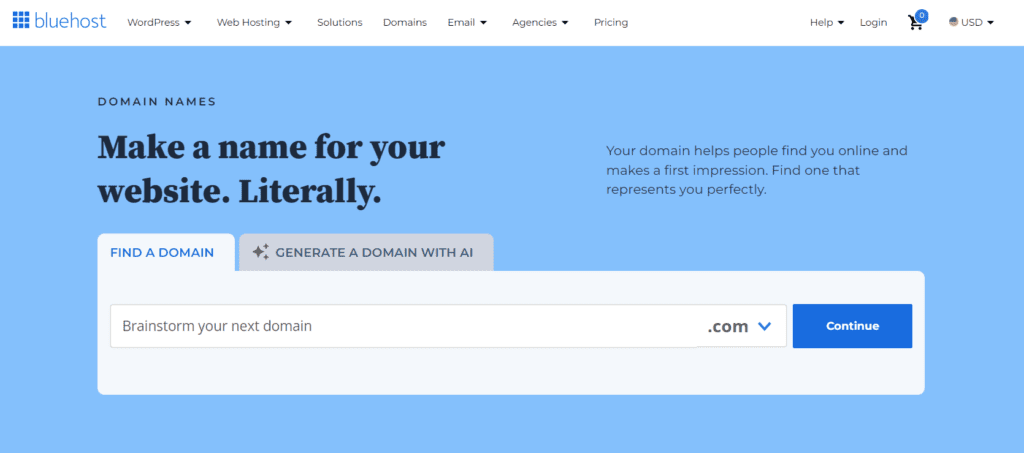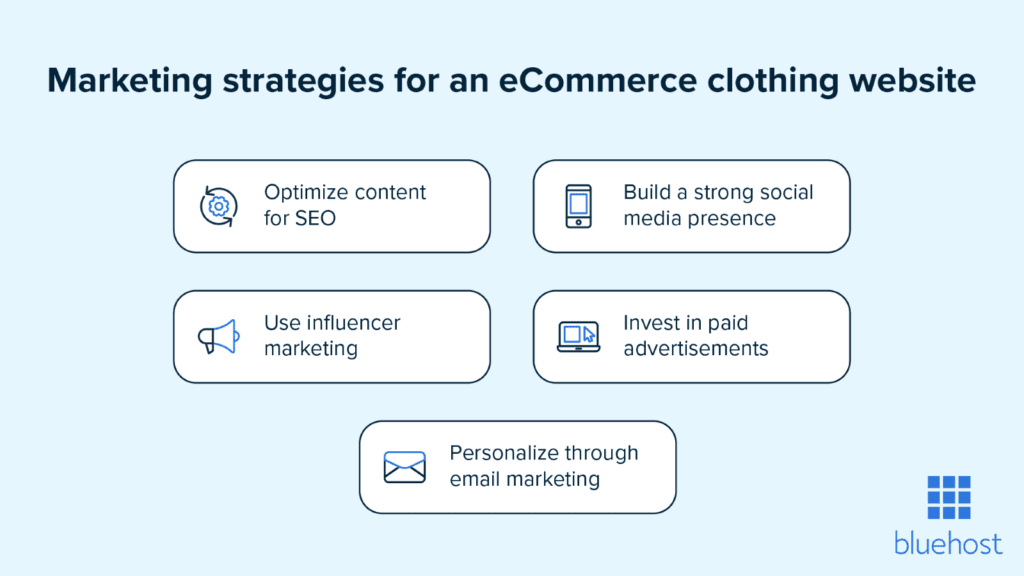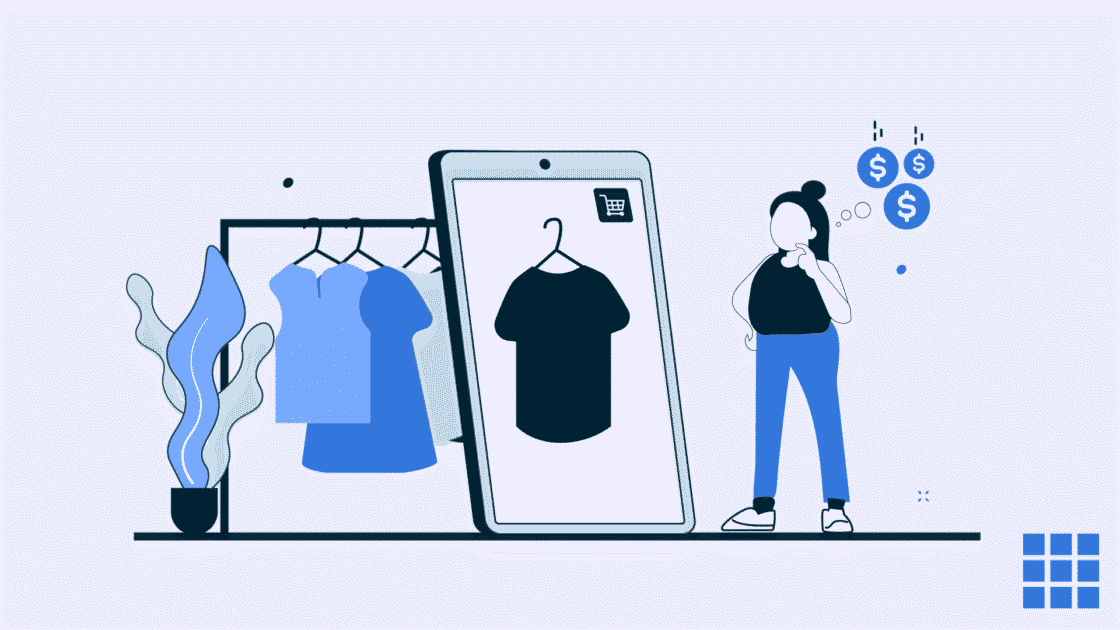Key highlights
- Understand how to sell clothes online by picking the right product type, new fashion, print-on-demand, secondhand or niche apparel.
- Compare marketplaces and standalone stores and see why owning your WooCommerce site offers better control and branding.
- Follow a clear setup process from hosting and design to product listings, payments and shipping simplified with Bluehost tools.
- Capture high-quality photos and optimize images to improve your store’s visual appeal and load speed.
- Grow your brand using SEO, social media, email campaigns and influencer partnerships to drive traffic and sales.
Ever dreamed of turning your closet into a cash machine? You’re not alone. The fashion eCommerce market is set to surpass $1 trillion in global sales by the end of 2025, making it one of the fastest-growing segments in online retail. Visual appeal plays a crucial role, with 72% of online shoppers stating that high-quality product images influence their buying decisions.
Whether you’re launching a fashion eCommerce store, building your personal brand with an own online clothing store, or simply exploring how to sell used clothes online for extra cash, the opportunities are vast. From selling secondhand clothing and vintage items to creating handmade items or designer pieces, there’s a business model suited for every seller.
In this comprehensive step-by-step guide, you’ll discover how to sell clothes online from home effectively – from choosing the right clothing items and sourcing methods to setting up payments, shipping and promotions. We’ll also cover essential product descriptions, social media marketing strategies and how to engage potential customers to boost sales and grow your clothing business.
Why is selling clothes online a smart business in 2025?
Fashion never goes out of style, and neither does the opportunity to sell it online. In 2025, selling clothes online remains one of the most promising ways to generate income, whether as a profitable side hustle or a full-time business. With more people shopping online than ever, demand is rising for unique, affordable clothing from independent sellers and small brands.
The beauty of selling clothes online lies in its flexibility and accessibility. You can start with minimal financial investment, choose your own hours and scale your business as you grow. From reselling everyday clothing like kidswear to launching a print-on-demand line or selling handmade and vintage items, there’s a suitable business model for every budget and skill level.
Whether you’re promoting your products through social media advertising, leveraging popular platforms like TikTok Shop or setting up your own store with complete control over branding and customer data, the market is wide open. Independent brands and casual sellers alike are thriving as shoppers increasingly support small stores offering curated styles, personal service and fast shipping.
So, what kind of clothes should you sell online to make the most of this opportunity?
What kind of clothes should you sell online?
Before you dive into your online clothing store setup or start designing product pages, it’s important to decide what kind of clothes you’ll be selling. This choice is key for beginners, as it shapes your pricing, shipping and marketing strategy.
Whether you want to start a fashion eCommerce store or flipping thrift finds, a niche helps you attract the right audience and grow steadily. If you’re exploring how to sell used clothes online or just figuring out your options, this table will help you compare the most common paths.
Here’s a quick comparison of the three main options for selling clothes online:
Planning guide: Product type vs sourcing vs tools
This table helps you compare the options side by side, so you can pick what suits your goals and budget best.
| Product type | Sourcing method | Tools needed |
| New fashion (own label) | Private suppliers, manufacturers | Design tools, supplier contact, product planner |
| Dropshipping | Spocket, AliExpress | WooCommerce plugin, market research tools |
| Print-on-demand | Printful, Printify, Gelato | POD plugin, mockup generator, website builder |
| Secondhand or vintage clothing | Thrift stores, consignment stores, personal closet | Camera, shipping label printer, packaging materials |
| Niche fashion | Boutique suppliers, small-batch creators | Niche tools, inventory tracker, shipping calculator |
Now let’s explore each one in more detail.
1. New fashion (own label)
Want to build your own clothing brand from the ground up? Selling new fashion under your own label means working with manufacturers or suppliers to create original designs. You’ll have full control over style, pricing and branding perfect for launching a distinct fashion identity.
- Ideal for: Aspiring fashion entrepreneurs
- Requires: Product design, supplier coordination, inventory management
- Best for: Brands aiming to scale and stand out with unique collections
2. Dropshipping
Looking for a low-risk way to start selling clothes online? Dropshipping lets you sell apparel without managing inventory. When a customer places an order, the supplier ships it directly. Your job is to curate the products, build your storefront and handle customer service.
- Ideal for: Beginners and side hustlers
- Requires: Finding reliable suppliers, syncing products to your store
- Best platforms: Spocket, AliExpress
3. Print-on-demand
Print-on-demand (POD) is a great option for creatives who want to sell custom designs. You upload your artwork on T-shirts, hoodies, baby clothes and more and the POD provider handles printing and shipping only after a customer places an order.
- Ideal for: Artists, influencers and niche creators
- Requires: Design skills, POD integration setup
- Best tools: Printful, Printify
4. Secondhand or vintage clothing
Selling secondhand or vintage fashion is both eco-conscious and cost-effective. You can resell items from your own closet, local thrift shops or estate sales. With careful curation and good photography, you can turn pre-loved clothing into a stylish and sustainable business.
- Ideal for: Thrift lovers, minimal investment sellers
- Requires: Sourcing, inspecting, cleaning and photographing items
- Best for: Poshmark, Depop, eBay or your own niche shop
5. Niche fashion (e.g., maternity, plus-size, streetwear)
Focusing on a niche lets you serve a specific audience with tailored styles and messaging. Niche markets like maternity wear, plus-size fashion, streetwear or adaptive clothing are often underserved. This gives you a unique chance to stand out and build a loyal customer base.
- Ideal for: Sellers catering to niche lifestyles or underserved body types
- Requires: Market research, focused branding, curated inventory
- Best for: Building a strong community around shared identity or fashion needs
Once you’ve chosen what kind of clothes to sell, the next step is deciding where to sell them. Usually, the main question is should you use an established marketplace or build your own online store?
Should you sell in a marketplace or create your own online store?
One of the most important decisions when starting your online clothing business is where to sell your products. Should you list your clothes on a well-known marketplace like Etsy or Poshmark? Or should you create your own branded store using WooCommerce?
Both paths have their benefits and choosing the right one depends on your goals, budget and how much control you want.
1. Selling on marketplaces
Marketplaces like Etsy, Poshmark and Amazon make it easy to start selling quickly. These platforms take care of traffic, payment and logistics. So, you can focus on selling and shipping your clothes.
Once you create a seller account, you can upload your product listings, set prices and start selling almost immediately. Most marketplaces also provide tools for handling shipping labels, tracking and customer communication.
This makes them ideal for testing your product ideas, reselling used clothes or managing a side hustle without a big upfront investment. However, you’ll be sharing the platform with thousands of other sellers. This leads to more competition and limited control over your branding.
Also read: How to Sell on Poshmark
2. Owning your online clothing store
When it comes to selling clothes online for beginners, owning your store is a game-changer. Building your own online clothing store setup gives you full control over design, branding, pricing and the overall customer experience. It’s the best long-term path if you’re serious about creating and growing a unique fashion brand.
This is where WooCommerce shines. As a powerful and flexible WordPress plugin, WooCommerce transforms your website into a fully customizable online store. It’s perfect for selling fashion items in multiple sizes, colors and categories.
You can personalize everything from the homepage to checkout and integrate tools for marketing, analytics and customer engagement. Best of all, you own your data and customer relationships.
Start with Bluehost WooCommerce hosting and get free domain, AI store builder and 24/7 support.
Marketplace vs website: Pros and cons
When figuring out how to sell clothes online, one of the first decisions you’ll face is where to sell. Should you list your products on an established online marketplace? Or should you invest time into building your own online clothing store with a platform like WooCommerce? Both options come with their own benefits and trade-offs, especially if you’re new to selling clothes online or setting up your first store.
Here’s a quick breakdown to help you compare selling on a marketplace vs launching your own fashion eCommerce store:
| Feature | Marketplace | Your own website (WooCommerce) |
| Ease of setup | Very easy | Requires some setup but more flexibility |
| Traffic source | Built-in shoppers | You bring your own traffic (SEO, marketing) |
| Fees | Listing & sales commissions | No listing fees—more profit in the long run |
| Branding control | Limited customization | Full control over design and messaging |
| Customer data | Limited customization | You own and manage your customer list |
| Scalability | Platform limits growth | Fully scalable with plugins and features |
Once you’ve chosen where to sell, it’s time to build your store and bring your clothing business to life. Here’s how to set up your online clothing store step by step.
How to set up your online clothing store with Bluehost step by step?
Thinking about how to start selling clothes on your own online clothing store? Whether you want to launch a clothing brand, start a side hustle selling used clothes or turn your fashion hobby into a full-time clothing business, we’ve got you covered.
At Bluehost, we make it easy to sell clothes online. From hosting to design and shipping, here’s your full guide to setting up a successful store complete with the tools, plugins and support you need.
Step 1: Choose a hosting plan
Start by visiting Bluehost website and choosing a plan tailored for online stores.
- Select WooCommerce hosting if you want a fully integrated store with product management tools built in.
- All plans include 1-click WordPress + WooCommerce install, free SSL and a free domain for the first year.
This is the foundation of your store, everything you need to start selling clothes online.
Step 2: Register a domain name

Your domain name is your brand’s digital identity. It should be memorable, relevant and easy to type.
- When you sign up with Bluehost, you’ll get a free domain (for the first year).
- Choose a brandable domain name that reflects your business.
- You can register your domain during checkout or via your Bluehost Marketplace.
Also read: How to Register a Domain Name with Bluehost
Step 3: Install WordPress & WooCommerce
With Bluehost, you don’t need to install anything manually—we take care of it for you.
Step 4: Choose a theme and design your store
Once WordPress is set up, it’s time to design your storefront. With Bluehost, you get WonderSuite, our AI Website Builder:
- Drag-and-drop builder that lets you design your store without coding or extra plugins.
- Pre-built eCommerce templates made for fashion, streetwear, kids clothing and more.
- Fast and SEO-optimized themes that load quickly and help improve your search rankings.
- Fully WooCommerce compatible, integrating product pages, filters and checkout seamlessly.
Step 5: Add your products
Now it’s time to showcase what you’re selling.
- Go to WooCommerce > Products > Add New.
- Upload high-quality product photos (multiple angles recommended).
- Add detailed descriptions, size options and price points.
- Use categories like Dresses, Streetwear, Accessories, Children’s clothes, etc.
- Apply tags like “used clothing”, “plus-size” or “vintage” for searchability.
You can even use plugins like YITH WooCommerce Membership to offer early access or VIP pricing to subscribers.
Step 6: Set up payments and shipping
A smooth checkout experience is key to getting more sales.
- Enable payment gateway like PayPal, Stripe or direct bank transfer.
- Configure shipping zones and rates (flat rate, free shipping or weight-based).
- Turn on tax settings if you’re required to collect sales tax in your region.
- Use YITH Gift Cards to run promotions.
- Offer appointment bookings for custom services.
- Use CreativeMail for order updates and post-purchase emails.
Also read: Best WooCommerce Payment Gateways for Online Store
Step 7: Optimize your store

To rank higher on Google and provide a great user experience, optimize both performance and SEO.
- Install Yoast SEO for on-page optimization, meta descriptions and keyword targeting.
- Use caching plugins like WP Rocket or LiteSpeed for faster load times.
- Ensure your store is mobile-friendly, most shoppers buy from their phones.
- Enable image compression and lazy loading to speed up browsing.
Step 8: Market your clothing store to drive traffic and sales

Once you’re live, it’s time to attract attention and turn visitors into paying customers.
- Promote on social media platforms and popular apps (Instagram, TikTok, Facebook Marketplace).
- Collaborate with micro-influencers or bloggers.
- Send professional email campaigns using CreativeMail, our built-in email marketing solution.
- Use our AI Builder to create blog posts, lookbooks and landing pages.
- Track your performance through your Bluehost dashboard to see which channels bring in the most traffic and sales. Then, adjust your strategy accordingly.
Great marketing turns your store from a hobby into a successful eCommerce business.
Also read: How to Build a Small Business Website
With your store setup complete, you may be wondering which tools can help you run and grow your business more effectively.
Top 5 tools to sell clothes online
Choosing the right tools can save time, streamline operations, and help boost your sales. Here are five must-have tools every online clothing seller should consider:
1. WooCommerce (store platform)
WooCommerce is a WordPress plugin that turns your site into a powerful eCommerce platform. It supports product variations (sizes, colors), secure payments, inventory tracking and integrates with hundreds of useful plugins. With Bluehost, WooCommerce comes pre-installed and optimized for performance, so you can launch your store faster without any setup hassles.
2. Printify / Printful (POD)
Ideal for sellers who want to launch custom clothing without holding inventory. These print-on-demand platforms let you design products, connect to your store and automatically fulfill orders when a customer makes a purchase.
3. Spocket (dropshipping)
Spocket is one of the most reliable tools for sourcing high-quality clothing from trusted suppliers. With easy WooCommerce integration, it enables you to import products and fulfill orders without handling inventory yourself. Bluehost hosting ensures your store runs smoothly, even as product catalogs expand.
4. CreativeMail (email marketing)
Built for WordPress and WooCommerce, CreativeMail helps you stay in touch with customers. Send promotions, product updates and cart recovery emails right from your store dashboard. Great for driving repeat sales. Plus, with Bluehost integration, you can manage campaigns directly from your dashboard for a seamless experience.
5. YITH plugins (store features)
YITH offers a suite of WooCommerce extensions to enhance your store from wishlist and membership features to gift cards and product filters. These plugins help you customize the shopping experience and boost conversions. Bluehost supports all major YITH plugins and ensures compatibility through regular updates and WooCommerce-friendly architecture.
To scale your store efficiently and keep operations smooth, the right toolkit makes a big difference. Whether you’re just starting or expanding your online clothing business, these tools will help you handle everything from sales to marketing with ease. Let’s break down exactly why we’re the best platform to help you sell clothes online with confidence.
Why choose Bluehost to launch your online clothing store?
When it comes to starting your online clothing store, we know what it takes to succeed. That’s why thousands of fashion entrepreneurs, thrift sellers and boutique owners trust Bluehost to power their websites.
Here’s what makes us the best platform to sell clothes online:
1. Free domain and SSL included
We believe starting your clothing brand should be easy and affordable. That’s why every Bluehost plan includes:
- A free domain name for the first year, so you can launch with your own custom web address.
- A free SSL certificate that secures your site and protects customer data, which is essential for gaining trust and enabling secure checkout.
- Automatic HTTPS configuration, helping you meet Google’s security standards and improving your store’s SEO rankings.
From the moment you sign up, you’ll have the digital essentials to launch a professional online clothing store without spending extra.
2. WooCommerce ready out of the box
With Bluehost, you don’t need to worry about installing or configuring your eCommerce tools we’ve done it for you.
- You get WooCommerce pre-installed so you can start building your product catalog right away.
- Add clothing products with variations like size, color, material and custom tags like “new”, “used clothing” or “handmade and vintage”.
- Easily manage pricing, set up taxes and track inventory from your dashboard.
- Use WooCommerce add-ons to support flash sales, product bundles or back-in-stock alerts.
This seamless integration lets you focus on growing your clothing business, not figuring out tech.
3. Easy payment and shipping setup
One of the biggest challenges new store owners face is handling payments and delivery—but we make it simple.
- Accept different payment types such as PayPal, Stripe, credit/debit cards or direct bank account transfers.
- Enable automatic tax calculation and real-time shipping rates.
- Set flat-rate, local or free shipping options depending on your location and audience.
- Print prepaid shipping labels and manage fulfillment for every clothing order right from your WooCommerce dashboard.
Whether you’re shipping from your living room or scaling to a warehouse, our platform adapts to your process.
4. AI onboarding and site designing with WonderSuite
Design is a big deal in fashion, and your online store should reflect your unique style. That’s why we give you access to our WonderSuite, which includes:
- WonderBlocks: Our visual editor that lets you design product pages, homepages, landing pages and more using a drag-and-drop interface.
- WonderStart: Our smart setup wizard that helps you launch your WordPress website quickly with easy, step-by-step guidance.
- WonderTheme: Our flexible WordPress theme with built-in layouts, optimized for performance, branding and fast store setup.
- WonderCart: Our WooCommerce toolkit that lets you manage products, payments and shipping from one simple, streamlined dashboard.
- WonderHelp: Our built-in support tool offering instant answers, tutorials and expert guidance directly inside your WordPress dashboard.
In short, you don’t need to hire a designer. We give you the freedom to build a site that looks just as good as the clothes you sell.
5. 24/7 expert support and scalable hosting

Every successful clothing store needs dependable support and the ability to grow. With Bluehost, you get both.
- 24/7 expert support via chat and phone from professionals who understand WordPress and WooCommerce.
- Scalable hosting plans that grow with your business whether you’re launching your first product or running flash sales to thousands.
- Fast load times, performance monitoring and one-click upgrades when your traffic spikes.
- Tools like automatic backups, domain management and malware protection so you can focus on fashion, not firewalls.
Our team is here to help you troubleshoot, optimize and succeed day or night.
Final thoughts
Selling clothes online in 2025 is easier than ever whether you’re launching a brand, reselling or starting a fashion side hustle. With clear strategy, right tools and user-friendly platform, your dream store can become a thriving business.
At Bluehost, we’re here to support you every step of the way from setting up your store and optimizing product pages to managing shipping and scaling your sales. Our WooCommerce hosting, drag-and-drop builder and expert support make it effortless to create a professional online clothing store.
Ready to turn your clothing idea into a full-time online business?
Start your store today with Bluehost WooCommerce hosting and confidently launch your online clothing business.
FAQs
WooCommerce is one of the best platforms for selling clothes online especially when paired with Bluehost’s optimized hosting. It gives you full control over your store, design and customer experience. If you prefer a marketplace, platforms like Poshmark or Etsy are great for secondhand or niche fashion.
Yes, you can use dropshipping or print-on-demand services to sell clothes without holding any stock. These methods allow you to upload product designs and your supplier handles production and shipping. It’s a great low-risk option for beginners.
You can start an online clothing store for as little as $100–$300. Additional costs depend on themes, marketing and how you price clothes for profit while covering shipping and transaction fees.
To legally sell clothing online, you’ll typically need:
1. A registered business (sole proprietorship, LLC, etc.)
2. A sales tax ID or business license (based on your location)
3. A business bank account for payments
4. Clear store policies, including returns, privacy and terms of service
Regulations vary by country and state, so it’s best to check with a legal or tax professional to stay compliant.
Making money selling clothes online means picking the right products. These should appeal to your target audience. Set competitive prices to attract buyers. Choose the best online platform to reach potential customers. Use high-quality photos to showcase your items. Write detailed product descriptions to inform shoppers. Use marketing strategies like social media ads and seasonal sales to increase visibility. Manage your inventory carefully to avoid issues. Provide excellent customer service to build trust. All these steps help create a successful clothing business that generates steady income.
Starting an online clothing resale business involves choosing the type of clothes to sell, selecting the right platform, setting up your store or seller account and creating attractive listings with quality photos and descriptions. Develop a pricing strategy that balances competitiveness and profit and promote your business through social media to boost sales. Consistent inventory, shipping and customer service management are key to growth.



Write A Comment